
LIMITED WARRANTY POLICY
IN THE UNITED STATES AND CANADA
ENERGY
®
warrants this product to the retail purchaser against any failure resulting
from original manufacturing defects in workmanship or materials. The warranty is
in effect for a period of: Speaker Section-five (5) years, Subwoofer Section-one (1)
year from date of purchase from an authorized ENERGY
®
dealer and is valid only if
the original dated bill of sale is presented when service is required.
The warranty does not cover damage caused during shipment, by accident, misuse,
abuse, neglect, unauthorized product modification, failure to follow the instructions
outlined in the owner’s manual, failure to perform routine maintenance, damage
resulting from unauthorized repairs or claims based upon misrepresentations of the
warranty by the seller.
WARRANTY SERVICE
If you require service for your ENERGY
®
speaker(s) at any time during the warranty
period, please contact:
1) the dealer from whom you purchased the product(s),
2) ENERGY NATIONAL SERVICE, 203 Eggert Road, Buffalo, N.Y. 14215
Tel: 716-896-9801 or
3) ENERGY
®
, a division of Audio Products International Corp., 3641 McNicoll
Avenue, Toronto, Ontario, Canada, M1X 1G5,
Tel: 416-321-1800.
4) Additional service centers can be found by checking the ENERGY
®
website:
www.energy-speakers.com or, by calling either of the
above numbers.
You will be responsible for transporting the speakers in adequate packaging to
protect them from damage in transit and for the shipping costs to an authorized
ENERGY
®
service center or to ENERGY
®
. If the product is returned for repair to
ENERGY
®
in Toronto or Buffalo, the costs of the return shipment to you will be paid
by ENERGY
®
, provided the repairs concerned fall within the Limited Warranty. The
ENERGY
®
Warranty is limited to repair or replacement of ENERGY
®
products. It
does not cover any incidental or consequential damage of any kind. If the
provisions in any advertisement, packing cartons or literature differ from those
specified in this warranty, the terms of the Limited Warranty prevail.
GARANTIE
GARANTIE AUX
ÉTATS-UNIS ET AU CANADA
La société ENERGY
®
garantit cet appareil contre toute défectuosité attribuable aux
pièces d’origine et à la main-d’oeuvre. Cette garantie est valide pendant une
période de cinq (5) ans (enceinte) et d’un (1) an (extreme graves) à partir de la date
d’achat auprès d’un revendeur ENERGY
®
agréé ; la garantie ne sera honorée que
sur présentation d’une pièce justificative de la date d’achat.
La garantie ne couvre aucun dommage subi pendant le transport ou imputable à un
accident, à une utilisation impropre ou abusive, à la négligence, à une modification
non autorisée, à la non-observance des instructions décrites dans le manuel de
l’utilisateur ou des directives d’entretien, ni aucun dommage subi par suite de
réparations non autorisées ou de réclamations fondées sur une mauvaise
interprétation des conditions de la présente garantie par le revendeur.
SERVICE SOUS GARANTIE
Dans l’éventualité où une réparation deviendrait nécessaire
pendant la période de couverture de la garantie, communiquez avec :
1) le revendeur auprès de qui l’appareil a été acheté,
2) ENERGY National Service, 203, Eggert Road, Buffalo, N.Y. 14215,
tél. : 716-896-9801 ou
3) ENERGY
®
, 3641, avenue McNicoll, Toronto (Ontario), Canada, M1X 1G5, tél. :
416-321-1800.
4) Pour connaître l'adresse de tous nos centres de service, consultez le site Web de
ENERGY
®
à www.energy-speakers.com ou composez l’un des numéros indiqués plus
haut.
Le propriétaire de l’appareil est responsable de son emballage et de tous frais
d’expédition à un centre de service ENERGY
®
agréé ou à ENERGY
®
.
Si l’appareil est expédié à ENERGY
®
à Toronto ou à Buffalo aux fins de réparation,
les frais de réexpédition seront assumés par ENERGY
®
à la condition que les
réparations effectuées soient couvertes par la garantie.
La garantie est limitée à la réparation ou au remplacement des appareils fabriqués et
distribués par ENERGY
®
. Elle ne couvre aucun dommage indirect ou consécutif de
quelque nature que ce soit. Si les conditions accompagnant toute publicité,
emballage ou documentation divergent de celles de la présente garantie, les
conditions de la présente garantie prévaudront.
WARRANTY
GARANTIE
Printed in Canada
7AI//ENP3S
owners
manual
S8.3
S10.3
S12.3

NOTES
11
Caution: To prevent the risk of electrical shock, match wide blades of plug to wide
slot, fully insert.
Read Instructions: All safety and operating instructions should be read before the
product is operated.
Retain instructions: Safety and operating instructions should be retained for future
reference.
Heed Warnings: All warnings on the product & operation instructions should be
adhered to.
Follow Instructions: All operating and use instructions should
be followed.
Cleaning: Unplug the product from the wall before cleaning. Do not use aerosol or
liquid cleaners, just a damp cloth.
Attachments: Do not use attachments not recommended by the product
manufacturer as they may cause hazards.
Water and moisture: Do not use this product near water.
Ventilation: Openings in the cabinet are provided for ventilation and to ensure
reliable operation and protect it from overheating so they must not be blocked or
covered by placing the product on a bed, sofa or other similar surface. This product
should not be placed in a built-in installation such as a bookcase or rack unless proper
ventilation is provided or the manufacturer's instructions have been adhered to.
Power Sources: This product should be operated only from the type of power source
indicated on the marking label. If you are not sure of the type of power supply in your
home, call your local power company.
Grounding or Polarization: This product may be equipped with a polarized
alternating current line plug. This plug will fit the power outlet in only one way as a
safety feature. If you are unable to insert the plug, try reversing it. If the plug should
still fail to fit, contact your electrician to replace your outlet. Do not defeat the safety
purpose of the plug.
Power Cord Protection: Power supply cords should be routed
so that they are not likely to be walked on or pinched by items placed upon or against
them, paying particular attention to cords at plugs, convenience receptacles and the
point where they exit from the product.
Overloading: Do not overload wall outlets or extension cords, as this can result in a
risk of electrical shock.
Object and Liquid Entry: Never push objects of any kind into this product through
openings as they may touch dangerous voltage points or short out parts that can result
in a fire or electrical shock. Never spill liquid of any kind on the product.
Servicing: Do not attempt to service this product yourself as openings or removing
covers may expose you to dangerous voltage or other hazards. Refer all servicing to
qualified personnel.
Heat: This product should be situated away from heat sources such as radiators, heat
registers, stoves, or other appliances (including amplifiers) that produce heat.
Non-Use Periods: The power cord of the product should be unplugged from the
outlet when left unused for a long period of time.
Damage Requiring Service: The product should be serviced by qualified personnel
when:
A. The power supply cord or the plug has been damaged; or
B. Objects have fallen, or liquid has been spilled into the
appliance; or
C. The product has been exposed to rain; or
D. The appliance does not appear to operate normally or
exhibits a marked change in performance; or
E. Product has been dropped, or the enclosure damaged.
F. If the product does not operate normally by following the
operating instructions.
INTRODUCTION
Congratulations on your purchase of ENERGY
®
speakers! Proprietary technology
and high quality manufacturing will allow you to enjoy the most natural and
accurate music reproduction for many years. The advice offered in this manual is
aimed at helping you maximize and maintain peak performance, and therefore, your
listening satisfaction. Please take the time to read all of the instructions contained
in this manual to make certain your system is properly installed and functioning
correctly.
BREAK-IN PERIOD
We strongly advise that you resist the temptation to play the ENERGY
®
speakers to
their full capabilities or experiment with critical placement and listening until they
have been properly broken in. This process should last approximately 50 hours. This
can be easily be done by putting your compact disc player on Repeat mode, while
playing a CD with a wide dynamic range at normal listening levels.
COMPANY BACKGROUND
ENERGY
®
speakers are the result of extensive research into accurate sonic
reproduction and represent the leading edge in speaker design and performance.
The finest components and cabinet materials combined with sophisticated
manufacturing and quality control procedures ensure many years of exceptional
performance and listening pleasure.
CABINET CARE
Great care and craftsmanship has gone into the construction and finish of the
cabinet. Periodically use a soft, dry cloth to remove dust or fingerprints. Do not use
paper towels or other abrasive materials as it may damage the finish.
NOTE: Please retain the carton and packing material for your Energy
products, to protect them in the event of a move or if they need to be
shipped to a service center. Product received damaged by a service center
that has been shipped by the end user in other than the original packaging
will be repaired, refurbished and properly packaged for return shipment, at
the end user's expense.
SUBWOOFER PLACEMENT
The placement of your new ENERGY
®
subwoofer is critical to its performance. The
three most common locations include: in the corner of the room (which can result in
a boomy or exaggerated low frequency response), placement along one wall but out
of the corner (moderate bass performance with increased fidelity over corner
placement), or alongside a front speaker (creating a better blend with the front
speaker, but sacrificing overall volume). Experimentation with subwoofer placement
is highly encouraged, as slight adjustments can create large benefits in sound
reproduction. To further test subwoofer placement, install the subwoofer temporarily
in your main listening position and while playing a familiar piece of music, walk
around the listening room until you find the best sounding position. This is a
possible location for the subwoofer to be placed.
TERMINOLOGY AND CONTROLS
Front Panel
1. Subwoofer Volume Control - This
knob can be adjusted to control the
level of output from your subwoofer.
The level chosen should allow the
subwoofer to blend its output with
that of the rest of your audio system.
2. Status Indicator – The ENERGY
®
logo found on the front panel will
illuminate in blue when the
subwoofer in functioning. If the unit
is in Auto mode and is not receiving
a signal, the light will remain off.
owners manual
IMPORTANT SAFETY
INSTRUCTIONS –
READ CAREFULLY!
2
The lightning flash with arrowhead symbol. Within an equilateral
triangle is intended to alert the user to the presence of uninsulated
“dangerous voltage” within the products enclosure that may be of
sufficient magnitude to constitute a risk of electric shock to persons.
The exclamation point within an equilateral triangle is intended to
alert the user to the presence of important operating and
maintenance (servicing) instructions in the literature accompanying
the appliance.
1
2

NOTES
10
Rear Panel
3. Crossover Control – This control allows for the adjustment of the low-pass
filter. Adjustments can infinitely be made from 50Hz to 110Hz. This will
determine the highest frequency that the subwoofer will play.
4. Phase Control – This allows for the
infinite adjustment of the phase of
the subwoofer, in relation to the
speakers used in your system, from -
180 degrees to +180 degrees.
5. Power Mode – This switch can be
set to either On, Off or Auto. If the
switch is in the Off position, the
subwoofer will not power up. If the
switch is in the On position, it will
constantly remain on. If the switch is
set to the Auto position, when a
signal is present the subwoofer will
turn on and will automatically turn
off several minutes after a signal is no
longer present.
6. X-Over Mode – This switch allows
for the selection of either X-Over
Mode (A) Crossover Activated or (B)
Crossover Bypassed. (Please see the
connections section for suggestions
on which mode is appropriate for
your installation.)
7. Sub In – This input is an RCA type
mono input.
8. High-Level Input – These are 5-way binding post type speaker connectors. The
High-Level inputs are designed to be used on receivers or amplifiers that do not
incorporate any RCA type subwoofer outputs. If your receiver is equipped with
an RCA type subwoofer output, these speaker level inputs should not
be utilized.
CONNECTING YOUR
ENERGY SUBWOOFER
CAUTION: All power should be turned off to your system before any
connections are made. Careful attention should be taken to ensure that all
electronic components are not connected to an AC source. Not doing so
could result in potential damage to the system.
There are two mutually exclusive methods to connect your subwoofer to your
receiver.
Method 1 – RCA – For Home Theater or LFE Applications
1. On the rear of the receiver there should be a single RCA type jack marked
“Subwoofer Out”. Connect a single RCA cable from that jack to the RCA Sub In
(#7) on the rear of the subwoofer. A standard male to male RCA cable is
needed.
2. After connecting the single low level Sub In (#7) connection, plug your
ENERGY
®
subwoofer into an AC outlet. Do not use the AC outlet on the rear of
your receiver.
3. Select either the X-Over Mode (A) or (B) (#6). The X-Over Mode (A) “Crossover
Activated” switch position should be used when connecting your ENERGY
®
subwoofer to a receiver without bass management or when you wish to
manually control the crossover and volume settings (such as in a music system).
The X-Over Mode (B) “Crossover Bypassed” switch position should be used
when connecting to a receiver with bass management (such as in a digital
surround sound movie system). This connection defeats the crossover feature
on the ENERGY
®
subwoofer, allowing this control to be handled by the receiver.
Adjusting the front panel Volume Control (#1) will still be required.
4. Ensure that the supplied vibration dampeners are installed in the high-level
speaker inputs, as this ensures that the inputs will not vibrate audibly.
5. See Final System Adjustments, below.
Method 2 – Speaker Level – For Music Applications
1. The other way to connect your subwoofer to your receiver is using a High-Level
(#8) (speaker wire) connection, by simply connecting the speaker wires from the
Front Left and Right Speaker Outputs on your receiver to the Left and Right
Inputs on the rear of the subwoofer (#8). It is imperative that speaker polarities
be maintained, one must connect the positive and negative wires to the
appropriate positive and negative terminals. Failure to do so will result in an out
of phase connection, severely limiting the amount of bass in your system.
2. After connecting the High-Level (#8) (speaker wire) between your receiver and
subwoofer, ensure no fray wires are touching, as this could cause a short circuit
and damage your electronics. Plug your ENERGY
®
subwoofer into an AC
outlet. Do not use the AC outlet on the rear of your receiver.
3. See Final System Adjustments, below.
Do NOT connect both RCA and High-Level connections simultaneously, as
this will damage your ENERGY subwoofer.
FINAL SYSTEM ADJUSTMENTS
1. After having turned on the main power switch and having broken-in the
speaker, select the correct position for the Power Mode switch (#5), either On
or Auto depending on your system. The Auto selection will leave the unit in a
self-sensing mode, such that should the unit sense an audio signal it will turn
itself on and then shut down after several minutes without signal, while in the
On position the subwoofer always remains on. Should the system not be used
for an extensive period of time, it is recommended that the subwoofer be
unplugged from the AC outlet.
2. Adjust the Volume Control (#1) on the front panel of your ENERGY
®
subwoofer
so that the volume of your subwoofer matches the overall system volume. This
ensures a smooth transition between the low and high frequencies of
your system.
3. Adjust the Crossover Setting (#3) on your ENERGY
®
Speakers subwoofer so that
the frequency range of the subwoofer blends well with that of the front
speakers (For use with all settings, except when in X-Over Mode (B)). Setting
the crossover too low will create a gap between the frequency response of the
front speakers and that of the subwoofer, while setting the crossover frequency
too high will create a doubling of certain frequencies, making the music sound
boomy. When using small satellite speakers, the appropriate crossover
frequency should be from 90Hz to 110Hz, for the bookshelf speakers70Hz to
90Hz and for the large crossover floorstanding speakers 50Hz to 70Hz.
4. Adjust the Phase control (#4) so that the subwoofer integrates fully with the rest
of your audio system. This control is infinitely adjustable and ensuring that the
subwoofer operates in phase with the rest of the system is critical, as an out of
phase subwoofer will either sound like it is lacking in bass performance or that
its timing is off. This setting will be determined by your listening position, the
characteristics of your listening room and its interaction with your ENERGY
®
subwoofer. An out of phase speaker means that the speaker cone is moving
inwards when it should be moving outwards, like the other speakers in your
system, causing cancellations of certain frequencies. By adjusting the phase
control, one can ensure that all speakers move in the proper direction, at the
same time.
5. Steps 2,3 and 4 might require repeating in order to fine tune your system.
Ensuring the proper blending between the speakers and the subwoofer is critical
to the performance of your system, as a whole.
WARRANTY OUTSIDE OF
THE UNITED STATES
Outside of North America, the warranty may be changed to comply with local
regulations. Ask your local ENERGY
®
dealer for details of the LIMITED WARRANTY
applicable in your country.
WARRANTY FOR THE UNITED STATES
AND CANADA
Please see the warranty document on the back cover
“ENERGY”, the “ENERGY” logo, are trademarks of Audio Products International Corp.
owners manual
3
3
4
5
6
8
7
Page is loading ...
Page is loading ...
Page is loading ...
Page is loading ...

LIMITED WARRANTY POLICY
IN THE UNITED STATES AND CANADA
ENERGY
®
warrants this product to the retail purchaser against any failure resulting
from original manufacturing defects in workmanship or materials. The warranty is
in effect for a period of: Speaker Section-five (5) years, Subwoofer Section-one (1)
year from date of purchase from an authorized ENERGY
®
dealer and is valid only if
the original dated bill of sale is presented when service is required.
The warranty does not cover damage caused during shipment, by accident, misuse,
abuse, neglect, unauthorized product modification, failure to follow the instructions
outlined in the owner’s manual, failure to perform routine maintenance, damage
resulting from unauthorized repairs or claims based upon misrepresentations of the
warranty by the seller.
WARRANTY SERVICE
If you require service for your ENERGY
®
speaker(s) at any time during the warranty
period, please contact:
1) the dealer from whom you purchased the product(s),
2) ENERGY NATIONAL SERVICE, 203 Eggert Road, Buffalo, N.Y. 14215
Tel: 716-896-9801 or
3) ENERGY
®
, a division of Audio Products International Corp., 3641 McNicoll
Avenue, Toronto, Ontario, Canada, M1X 1G5,
Tel: 416-321-1800.
4) Additional service centers can be found by checking the ENERGY
®
website:
www.energy-speakers.com or, by calling either of the
above numbers.
You will be responsible for transporting the speakers in adequate packaging to
protect them from damage in transit and for the shipping costs to an authorized
ENERGY
®
service center or to ENERGY
®
. If the product is returned for repair to
ENERGY
®
in Toronto or Buffalo, the costs of the return shipment to you will be paid
by ENERGY
®
, provided the repairs concerned fall within the Limited Warranty. The
ENERGY
®
Warranty is limited to repair or replacement of ENERGY
®
products. It
does not cover any incidental or consequential damage of any kind. If the
provisions in any advertisement, packing cartons or literature differ from those
specified in this warranty, the terms of the Limited Warranty prevail.
GARANTIE
GARANTIE AUX
ÉTATS-UNIS ET AU CANADA
La société ENERGY
®
garantit cet appareil contre toute défectuosité attribuable aux
pièces d’origine et à la main-d’oeuvre. Cette garantie est valide pendant une
période de cinq (5) ans (enceinte) et d’un (1) an (extreme graves) à partir de la date
d’achat auprès d’un revendeur ENERGY
®
agréé ; la garantie ne sera honorée que
sur présentation d’une pièce justificative de la date d’achat.
La garantie ne couvre aucun dommage subi pendant le transport ou imputable à un
accident, à une utilisation impropre ou abusive, à la négligence, à une modification
non autorisée, à la non-observance des instructions décrites dans le manuel de
l’utilisateur ou des directives d’entretien, ni aucun dommage subi par suite de
réparations non autorisées ou de réclamations fondées sur une mauvaise
interprétation des conditions de la présente garantie par le revendeur.
SERVICE SOUS GARANTIE
Dans l’éventualité où une réparation deviendrait nécessaire
pendant la période de couverture de la garantie, communiquez avec :
1) le revendeur auprès de qui l’appareil a été acheté,
2) ENERGY National Service, 203, Eggert Road, Buffalo, N.Y. 14215,
tél. : 716-896-9801 ou
3) ENERGY
®
, 3641, avenue McNicoll, Toronto (Ontario), Canada, M1X 1G5, tél. :
416-321-1800.
4) Pour connaître l'adresse de tous nos centres de service, consultez le site Web de
ENERGY
®
à www.energy-speakers.com ou composez l’un des numéros indiqués plus
haut.
Le propriétaire de l’appareil est responsable de son emballage et de tous frais
d’expédition à un centre de service ENERGY
®
agréé ou à ENERGY
®
.
Si l’appareil est expédié à ENERGY
®
à Toronto ou à Buffalo aux fins de réparation,
les frais de réexpédition seront assumés par ENERGY
®
à la condition que les
réparations effectuées soient couvertes par la garantie.
La garantie est limitée à la réparation ou au remplacement des appareils fabriqués et
distribués par ENERGY
®
. Elle ne couvre aucun dommage indirect ou consécutif de
quelque nature que ce soit. Si les conditions accompagnant toute publicité,
emballage ou documentation divergent de celles de la présente garantie, les
conditions de la présente garantie prévaudront.
WARRANTY
GARANTIE
Printed in Canada
7AI//ENP3S
owners
manual
S8.3
S10.3
S12.3
-
 1
1
-
 2
2
-
 3
3
-
 4
4
-
 5
5
-
 6
6
-
 7
7
-
 8
8
Energy Speaker Systems Energy S12.3 User manual
- Category
- Subwoofers
- Type
- User manual
Ask a question and I''ll find the answer in the document
Finding information in a document is now easier with AI
in other languages
Related papers
-
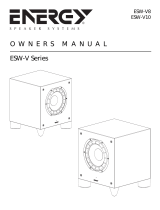 Energy Speaker Systems ESW-V10 User manual
Energy Speaker Systems ESW-V10 User manual
-
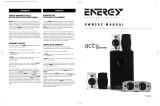 Energy Speaker Systems act Cinema User manual
Energy Speaker Systems act Cinema User manual
-
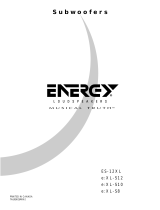 Energy Speaker Systems e:XL-S10 User manual
Energy Speaker Systems e:XL-S10 User manual
-
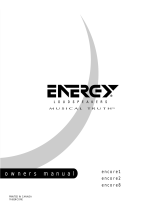 Energy Speaker Systems MUSICAL TRUTH encore1 User manual
Energy Speaker Systems MUSICAL TRUTH encore1 User manual
-
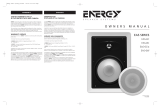 Energy Speaker Systems Energy EAS-8C User manual
Energy Speaker Systems Energy EAS-8C User manual
-
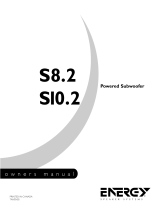 Energy Speaker Systems S10.2 User manual
Energy Speaker Systems S10.2 User manual
-
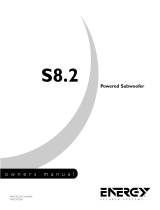 Energy Speaker Systems S8.2 User manual
Energy Speaker Systems S8.2 User manual
-
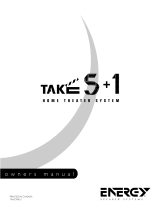 Energy Speaker Systems Energy RC-Micro TAKE 5+1 User manual
Energy Speaker Systems Energy RC-Micro TAKE 5+1 User manual
-
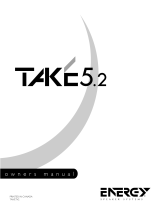 Energy Speaker Systems Speaker System TAKE 5.2 User manual
Energy Speaker Systems Speaker System TAKE 5.2 User manual
-
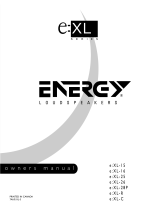 Energy Speaker Systems e:XL-26 User manual
Energy Speaker Systems e:XL-26 User manual
Other documents
-
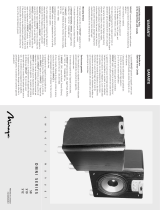 Mirage Loudspeakers S10 User manual
Mirage Loudspeakers S10 User manual
-
Energy Take Classic 5.1 User manual
-
Athena Technologies S1 User manual
-
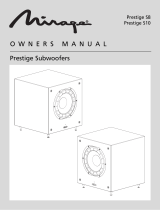 Mirage Loudspeakers Prestige S10 User manual
Mirage Loudspeakers Prestige S10 User manual
-
Panasonic SB-TP100 User manual
-
Panasonic SBTP100 Owner's manual
-
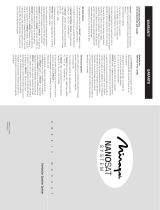 Mirage Loudspeakers Omni Series User manual
Mirage Loudspeakers Omni Series User manual
-
Mirage MS-12 Owner's manual
-
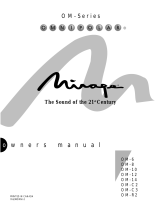 Mirage Loudspeakers OM-12 User manual
Mirage Loudspeakers OM-12 User manual
-
Paradigm Cinema 100 CT User manual





















